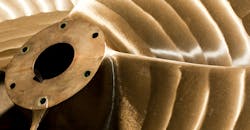3D Systems, Newport News Developing Marine Alloys for 3DP
Additive manufacturing specialist 3D Systems reported it is collaborating with Huntington Ingalls Industries’ Newport News Shipbuilding division to develop copper-nickel (CuNi) and nickel-copper (NiCu) alloys for powder-bed fusion production – potentially allowing NNS to replace castings with additively manufactured parts, and to cut lead times by up to 75%.
CuNi and NiCu are corrosion-resistant alloys with high strength and durability across a wide range of temperatures. However, components produced in these alloys require long lead times (sometimes more than one year, according to 3DS) and multiple suppliers. A successful powder-metal formulation that could be available for metal 3D printing could shorten the supply chain considerably, it is proposed.
Newport News Shipbuilding is the sole designer, builder, and refueler of U.S. Navy aircraft carriers and one of two providers of U.S. Navy submarines.
3D Systems develops hardware, software, and materials used in additive manufacturing, including printer systems for metal additive manufacturing. The “powder-bed fusion” process is also known as selective laser sintering or “binder-jet” additive manufacturing and involves a printer-head device selectively depositing a liquid binder onto a layer of powdered materials (e.g., powdered CuNi and NiCu), creating a series of layers according to a pattern defined by a CAD file of the finished part. A finished form results when successive layers are completed, and the formed part is later sintered with a combination of heat and atmospheric pressure to densify the structure.
3D Systems is working with NNS to select the specific alloy composition, design the process parameter experiments, and qualify parts -- including tensile and other material testing. Newport News Shipbuilding would be able to use the new materials with its current metal AM capabilities to produce replacement parts for castings as well as valves, housings, and brackets.
Once the CuNi and NiCu materials have been demonstrated successful, 3D Systems anticipates they will be added to its materials portfolio and would be available for corrosion-resistant applications in other industries, like oil-and-gas production and refining, and utility energy production.
3D Systems and Newport News Shipbuilding established a joint development agreement in 2018 to qualify metal additive manufacturing technologies for naval warships. 3D Systems provided Newport News with a ProX® DMP 320 powder-bed fusion system, and the new alloys to be developed for Newport News’ applications needs will allow it to expand its use of additive manufacturing.
According to said 3D Systems CTO Chuck Hull, “Through our on-going collaboration with Newport News Shipbuilding, we have yet another opportunity to bring to bear our deep materials science and application engineering expertise – allowing our customers to maximize the power of additive manufacturing within their organization. These new materials have the potential to redefine Newport News Shipbuilding’s innovation pipeline enabling them to more efficiently deliver high-quality parts.”
